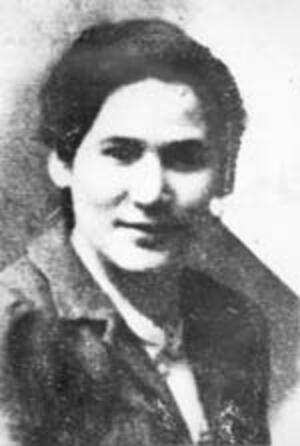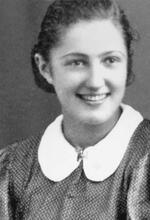Roza Robota
Roza Robota was born in Ciechanow, Poland, where she was active in the Ha-shomer ha-Za’ir youth movement before joining the movement’s underground in the ghetto. In 1942 she was deported with her family to Auschwitz but was transferred to Birkenau soon after. She organized a rebel group and was part of the revolt of the Sonderkommando in 1944. She was arrested alone with other women prisoners involved in the explosion and was continuously tortured and interrogated. She was hanged in the presence of other prisoners, singing “Hatikvah” in her final moments. Her heroism is remembered as one of the most courageous acts of Jewish women prisoners during the Holocaust.
A member of the Jewish underground in the Auschwitz-Birkenau death camp, Roza Robota was one of the organizers of an operation to smuggle explosives for use by members of the Sonderkommando (Jewish forced-labor unit of concentration camp prisoners) in the October 7, 1944 revolt at the camp.
Robota was born in 1921 or 1923 in Ciechanow, Poland, where she was active in the Ha-Shomer ha-Za’ir youth movement before joining the movement’s underground in the Ciechanow ghetto. In 1942 she was deported with her family to Auschwitz; there she lost her entire family in the selektsia (selection) process whereby inmates were sent directly to their deaths or into forced labor. Robota was initially imprisoned in the first women’s camp (in Auschwitz I), but was transferred to Birkenau when the women’s camp was relocated there in August 1942.
Robota worked in the clothing kommando (labor unit) where the personal belongings of the dead were sorted; over time, she attained a relatively high status at this post. Robota organized a rebel group within the kommando and made contact with the Jewish underground in the camp. The unit worked in the complex bordering crematorium no. IV, that is, in the area of the Sonderkommando.
Revolt of the Sonderkommando
The Jewish underground in Auschwitz I requested Robota’s help in organizing the smuggling of explosives from the Weichsel-Union-Metallwerke factory, where detonators for artillery shells were manufactured, to members of the Jewish underground and the Sonderkommando. Robota made contact with three Jewish women prisoners who worked in the section of the factory responsible for producing gunpowder, where all the laborers were Jewish women. These three prisoners (Ala Gertner, Regina Safirsztajn, and Ester Wajsblum) smuggled the explosives in match boxes at tremendous risk to themselves. Roughly twenty other Jewish women prisoners took part in the operation, among them Hannaleh Wajsblum (Ester’s sister), Faige Segal, Mala Weinstein, Hadassah Zlotnicka, and others whose names are unknown. All of the women prisoners were aged between eighteen and twenty-two. Robota would receive the explosives from them and pass them on to the Sonderkommando. Several Jewish male prisoners (Yehuda Laufer, Israel Gutman, and Noah Zabludowicz) were also involved in transferring the materiel. The Sonderkommando would transport the explosives from inside the camp in a wagon used for removing the corpses of those who had died during the night. The materiel was hidden under the bodies and concealed in the crematoria. The preparations continued over the course of one and a half years.
On October 7, 1944, the revolt of the Sonderkommando broke out. In its aftermath, a sweeping investigation was carried out by the camp’s Gestapo—Political Department. Roughly three days after the revolt, on about October 9 or 10, the investigators reached Ala Gertner, Regina Safirsztajn, and Ester Wajsblum and arrested them for interrogation. The three were brutally tortured, but did not reveal the names of the other male and female prisoners who had taken part in the smuggling of the explosives. After several weeks of interrogation, the women were released and returned to their work at the factory. The Germans brought in an undercover agent named Eugen Koch, a half-Jew from Czechoslovakia, ostensibly to head one of the work squads. Koch was able to discover the names of other women prisoners who had taken part in the smuggling, leading to the rearrest of the three original women prisoners, together with Robota. The Jewish underground in the camp was gripped by fear, in particular due to the arrest of Robota, who knew the names of many of their members, especially the inner circle, and some of their methods of operation. Although Robota, Gertner, Safirsztajn, and Wajsblum were subjected to severe torture they did not divulge the names of their comrades in the revolt.
Capture and Execution
After persuading the kapo of the torture bunker, Ya’akov Kozelczyk, to let him in, Noah Zabludowicz, a fellow underground member from the same city as Robota, managed to visit her there: “I entered Roza’s cell. On the cold cement lay a figure like a heap of rags. At the sound of the door opening, she turned her face to me…Then she spoke her last words. She told me that she had not betrayed [anyone]. She wished to tell her comrades that they had nothing to fear. We must carry on. It was easier for her to die knowing that our actions would continue. It was a pity to lose one’s life and have to leave this world, but she did not regret her actions. She was not sorry that it was her lot to die. I received from her a note for the comrades outside. It was signed with the exhortation: Hazak ve-amatz (be strong and of good courage)! The time came to leave, and I left the bunker. This was the last time I saw Roza face to face, but I will never forget her.” (Gutman 1957, 214).
On January 6, 1945, some two weeks before the camp was evacuated, Robota, Gertner, Safirsztajn, and Wajsblum were hanged in the presence of the other prisoners. Two were executed at night (Ala Gertner and Roza Robota) and two by day (Ester Wajsblum and Regina Safirsztajn). In their final moments, they cried out for vengeance and sang the “Hatikvah” national anthem. Theirs was the last execution in the camp. Their heroic stand is remembered as one of the most courageous acts of Jewish women prisoners in Auschwitz-Birkenau.
Czech, D. Auschwitz Chronicle, 1939–1945. London/New York: Henry Holt & Co, 1990.
Gutman, Israel. “Introduction.” In Anashim ve-Efer: Sefer Auschwitz-Birkenau, edited by Israel Gutman in conjunction with a group of prisoner-comrades (Hebrew). Merhavia: Sifriyat Po’alim, 1957.
Gutman, Israel, and M. Berenbaum, ed. Anatomy of the Auschwitz Death Camp. Bloomington, IN/Washington, DC: Indiana University Press, 1994, 1998.
Kagan, Raya. Women in the Chamber of Hell (Auschwitz Chapters) (Hebrew). Tel Aviv: Sifriyat Po’alim, 1947.
Marek, B. Scroll of Auschwitz (Hebrew). Tel Aviv: Am Oved, 1978.
Weinstein, M. “Memoirs from the Auschwitz Revolt” (Hebrew). Yediot Yad Vashem 34 (April 1965).
Zabludowicz, Noah. “A Visit with Roza in the Bunker.” In Anashim ve-Efer: Sefer Auschwitz-Birkenau, edited by Israel Gutman in conjunction with a group of prisoner-comrades (Hebrew). Merhavia: Sifriyat Po’alim, 1957.




